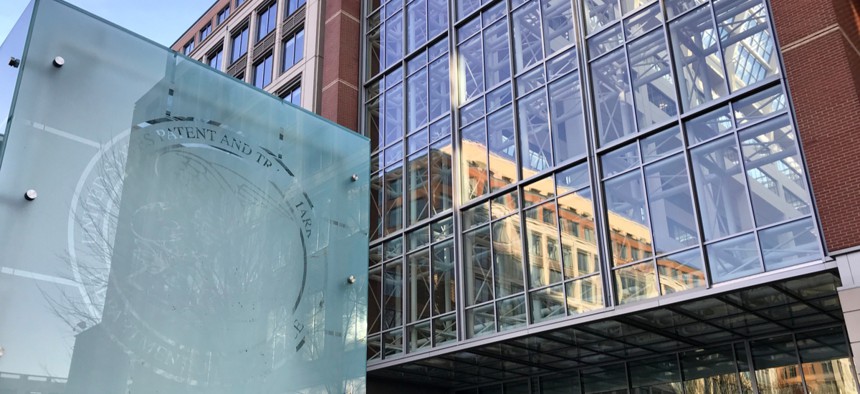How USPTO Avoided the Strains of Pandemic-Forced Mass Telework

jer123/Shutterstock.com
U.S. Patent and Trademark Office Chief Information Officer Jamie Holcombe shared new details about the agency's increased productivity.
Strategic modernization moves and the deliberate development of a robust teleworking infrastructure prior to the COVID-19 pandemic palpably paid off for the United States Patent and Trademark Office when the global health crisis hit, according to the agency’s Chief Information Officer Jamie Holcombe.
“We were talking about how the pandemic has actually affected our work—and it's amazing,” Holcombe said during a virtual ACT-IAC panel Wednesday. “Most people are—well, they have to be—[experiencing] mandatory telework and the fact of the matter is because people haven't been taking vacation, we've seen an uptick in productivity numbers. So we're actually doing better than we did year over year, as compared to years prior.”
The CIO, who’s been spearheading a massive IT-modernizing campaign to revamp how the agency buys and operates technology, detailed the impacts previous progress is having on USPTO’s present teleworking reality, and also shed light on ongoing artificial intelligence-focused programs producing results in the new normal and how officials are working to boost public access to the office’s rich collection of data.
While many other agencies struggled and some are still scrambling to securely adjust to nationwide work-from-home orders that are only beginning to lift in some states, Holcombe said USPTO experienced “telework serendipity” at the front end of the COVID-19 emergency.
In January, the agency was getting ready to move to the cloud, and in doing so was increasing bandwidth capacity for more pipe volume to manage the workloads. Raising the speed of connections, the agency moved from a 6 gigabit per second circuit to a 10 Gbps circuit. “Serendipity as it would have it,” according to Holcombe, who emphasized that when the pandemic emerged USPTO was able to make good use of the added space. The agency “easily took in” thousands of personnel with the backbone and is now experiencing “max bandwidth of about 8 gig.”
“Capacity is a big deal, and one of the big things I've been saying to other agencies’ CIOs, is ‘you have to set these things up before the actual crisis hits. So right now we should be planning to double your capacity and have those contract vehicles in place ... to execute on a moment's notice,’” Holcombe said. “This is what needs to happen in the future.”
A huge portion of its employees were already often working from home at the onset of the pandemic, but USPTO swiftly moved to support new teleworkers by the thousands early on and now enables around 1,200 WebEx sessions every day during which anywhere between 14 and 40 employees collaborate and meet.
“As you can imagine, we are maxing out our licensing, we're maxing out our bandwidth. But because of the great tuning capability and great competence of our IT staff, we are able to answer any problems that occur,” Holcombe added. “We did have slight problems in the beginning, but what we did to combat that was to ensure that we scaled up both software licenses and hardware licenses to ensure that we could manage and respond to the demand.”
Presently, the agency is also embarking on six unique AI-centered programs, and the “greatest results” they’ve seen so far relate to the classification of patents, the CIO said, noting that the team is “relearning the algorithms to do a supervised neural network feedback loop.” In doing so, USPTO has gained “very precise classifications” to use going forward in a dedicated effort to “drive the workflow to become quicker and better—more accurate and faster”, Holcombe noted. The agency is also turning to AI and machine learning tools to create a neural network in its trademarks’ fraud detection, with image search and classification.
“These are great things that are forthcoming in the future,” Holcombe said.
Another priority within the agency is to offer the public “new valuable services” that enable stakeholders the ability to seamlessly make use of—and draw new insights from—the agency's vast amounts of data. Among other new initiatives, in May, USPTO launched Patents 4 Partnerships, a searchable repository for all applications available for licencing. Launched within 10 days, the hope is that the platform connects individuals and entities that have technologies they aim to license with those that can help commercialize the tech.
“That's something that we're trying to do in the future and get done more and more is provide more data services to the public,” Holcombe explained. “And we're really looking forward to filling the holes that are out there, because we've listened to you, and we know there's a lot of data that's needed to go out to the community and we're going to try to do that within the next six months.”
Through the pandemic, the agency has continued to embark on the ambitious transformation effort that’s occurred over the last 15 months. Holcombe is leading the charge as USPTO insiders work to “eliminate technical debt,” or remove and upgrade systems across the enterprise. When possible, Holcombe said the agency works to “also modernize these systems as a leapfrog effect.”
“And because of that, what I wanted to ask is—anybody out there with great leapfrog ideas, I'm all ears. The fact of the matter is you can throw me some unsolicited ideas on how to leapfrog ahead and move forward in all of our efforts here on IT modernization,” he said, later reiterating, “If you've done something good in the federal government or elsewhere and you think it applies to us, please bring it forward. We can't wait to do things in a new way.”
RELATED PODCAST






